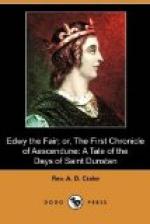Here was drawn up the famous Benedictine rule, which was far more adapted than any other code to prevent the cloister from becoming the abode of idleness or lascivious ease. To the three vows of poverty, chastity, and obedience, was added the obligation of manual labour, the brethren being required to work with their hands at least seven hours daily. The profession for life was preceded by a novitiate of one year, during which the rule was deeply studied by the novice, that the life vow might not be taken without due consideration. The colour of the habit was usually dark, hence the brethren were called the Black Monks.
St. Benedict died of a fever, which he caught in ministering to the poor, on the eve of Passion Sunday, A.D. 543. Before his death, the houses of the order were to be found in all parts of Europe, and by the ninth century it had become general throughout the Church, almost superseding all other orders.
xviii The Roman Roads.
Roman roads were thus constructed: Two shallow trenches were dug parallel to each other, marking the breadth of the proposed road; the loose earth was removed till a solid foundation was reached, and above this were laid four distinct strata—the first of small broken stones, the second of rubble, the third of fragments of bricks or pottery, and the fourth the pavement, composed of large blocks of solid stone, so joined as to present a perfectly even surface. Regular footpaths were raised on each side, and covered with gravel. Milestones divided them accurately. Mountains were pierced by cuttings or tunnels, and arches thrown over valleys or streams. Upon these roads, posting houses existed at intervals of six miles, each provided with forty horses, so that journeys of more than 150 miles were sometimes accomplished in one day.
From the arrival of our uncivilised anceators, these magnificent roads were left to ruin and decay, and sometimes became the quarry whence the thane or baron drew stones for his castle; but they still formed the channels of communication for centuries. Henry of Huntingdon (circa 1154) mentions the Icknield Street, from east to west; the Eringe, or Ermine Street, from south to north; the Watling Street, from southeast to northwest; and the Foss Way, from northeast to southwest, as the four principal highways of Britain in his day. Once ruined, no communications so perfect existed until these days of railroads.
xix The Rollright Stones.
These stones are still to be seen in the parish of Great Rollright near Chipping Norton, Oxon, anciently Rollrich or Rholdrwygg. They lie on the edge of an old Roman trackway, well defined, which extends along the watershed between Thames and Avon. The writer has himself heard from the rustics of the neighbourhood the explanation given by Oswy, while that put in the mouth of Father Cuthbert is the opinion of the learned.
xx For this new translation of Urbs beata the author is indebted to his friend the Rev. Gerald Moultrie.




